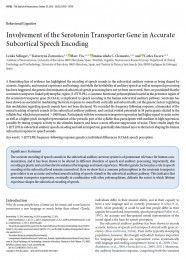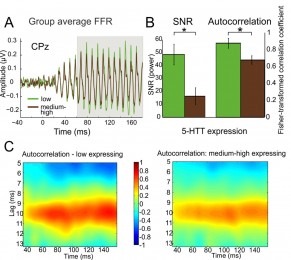 In its issue dated October 18th, 2016, The Journal of Neuroscience publishes a new paper from the Brainlab. The paper is entitled Involvement of the serotonin transporter gene in accurate subcortical speech encoding, and co-authored by Selinger, Zarnowiec, Via, Clemente, & Escera.
In its issue dated October 18th, 2016, The Journal of Neuroscience publishes a new paper from the Brainlab. The paper is entitled Involvement of the serotonin transporter gene in accurate subcortical speech encoding, and co-authored by Selinger, Zarnowiec, Via, Clemente, & Escera.
In this paper we show that the frequency-following response (FFR), known as the biological signature of speech-sound processing in the subcortical auditory system, is under the influence of the serotonin transpoter. Specifically, we observed a genetically driven stronger encoding of the speech syllabe /ba/ for indivuals having a low expression of the serotonin transporter gene (SLC6A4) compared to those with medium and high expresison.
The full abstract reads as follows:
A flourishing line of evidence has highlighted the encoding of speech sounds in the subcortical auditory system as being shaped by acoustic, linguistic and musical experience and training. And while the heritability of auditory speech as well as non-speech processing has been suggested, the genetic determinants of subcortical speech processing have not yet been uncovered. Here, we postulated that the serotonin transporter-linked polymorphic region (5-HTTLPR), a common functional polymorphism located in the promoter region of the serotonin transporter gene (SLC6A4), is implicated in speech encoding in the human subcortical auditory pathway. Serotonin has been shown as essential for modulating the brain response to sound both cortically and subcortically, yet the genetic factors regulating this modulation regarding speech sounds have not been disclosed. We recorded the frequency following response, a biomarker of the neural tracking of speech sounds in the subcortical auditory pathway, and cortical evoked potentials in 58 participants elicited to the syllable /ba/, which was presented over 2000 times. Participants with low serotonin transporter expression had higher signal-to-noise ratios as well as a higher pitch strength representation of the periodic part of the syllable than participants with a medium-high expression, possibly by tuning synaptic activity to the stimulus features and hence a more efficient suppression of noise. These results imply the 5-HTTLPR in subcortical auditory speech encoding and add an important, genetically determined layer to the factors shaping the human subcortical response to speech sounds.
Full reference: 113. Selinger, L., Zarnowiek, K., Via, M., Clemente, I.C., Escera, C. (2016). Involvement of the serotonong transporter gene in accurate subcortical speech encoding. Journal of Neuroscience, 36(42), 10782-10790.


